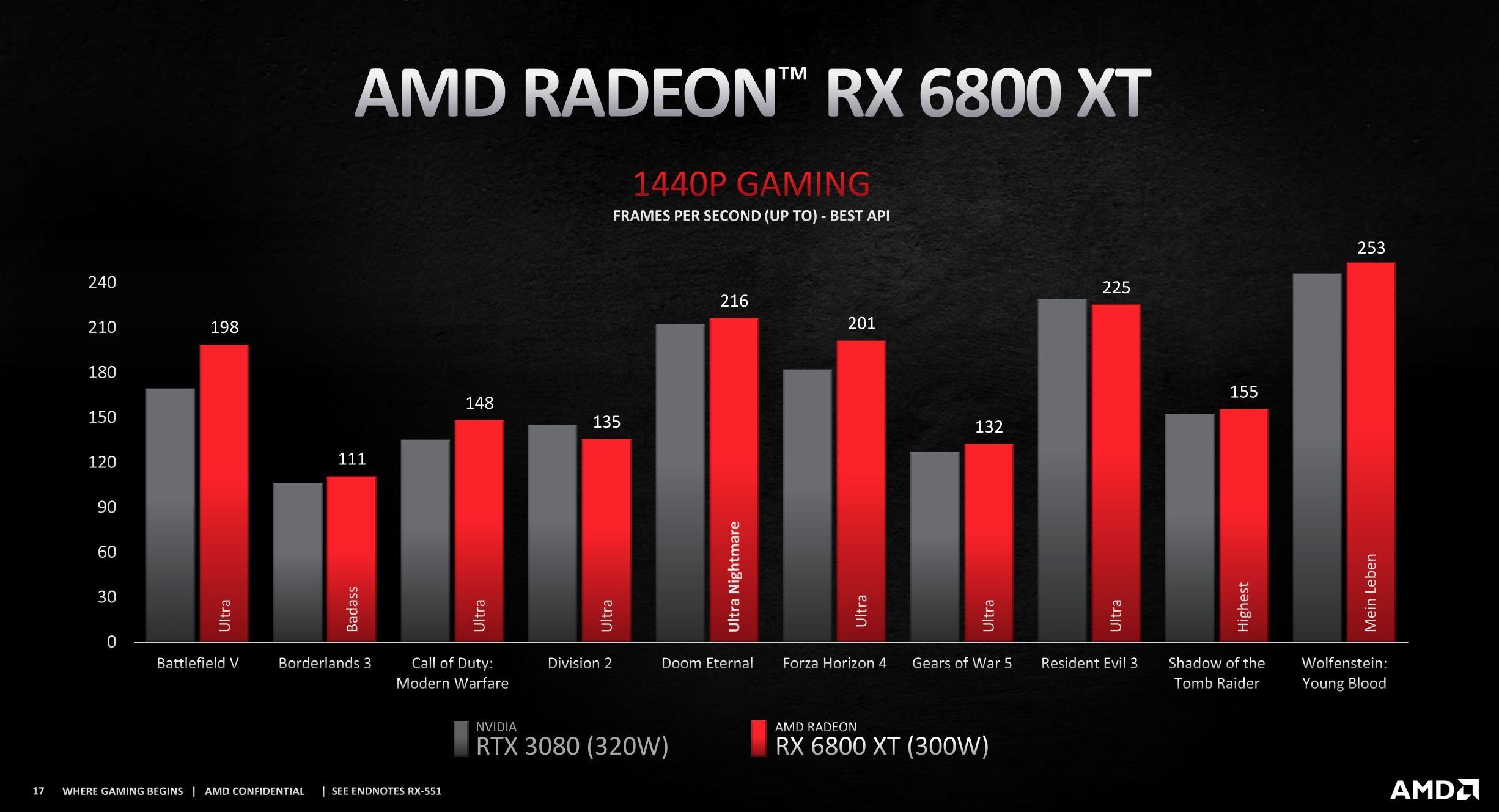Nvidia RTX 3080 vs AMD Radeon RX 6800 XT: Which graphics card will win?

It seemed for a brief moment that Nvidia was about to drive away in the graphics card race with the launch of the RTX 3000 series of cards. But AMD was holding back, revving its engines only to drop the clutch and zoom towards team green. After years, Nvidia and AMD are going at it neck and neck, each bringing very powerful and capable cards to market.
For consumers, increased competition is a good thing. It was fear of what AMD could bring with Vega that Nvidia released the 1080 Ti, a graphics card so good that many of its users forwent upgrading to the 2000 series. And Nvidia even priced the RTX 3080 aggressively, hoping that any affront by AMD would be blunted.
- The best gaming PCs to buy now
- Our picks for the best gaming laptops
- Where to buy AMD Radeon RX 6800 XT — check US and UK stock here
Well, AMD isn’t here to play. To take on the RTX 3080, AMD will be bringing out the Radeon RX 6800 XT. On paper, it performs at or slightly above the RTX 3080, while being $50 less and including six more GBs of memory. Things just got interesting.
Here’s a breakdown of everything you need to know about Nvidia RTX 3080 vs AMD RX 6800 XT.
Nvidia RTX 3080 vs AMD RX 6800 XT: Price and availability
The Nvidia RTX 3080 launched on September 17th, and sells for $699. However, Nvidia’s new card has been nearly impossible to find since it first came out, with many scalpers selling it online at exorbitant prices.
The RX 6800 XT is due out on November 18, and will undercut the RTX 3080 by $50 with a price tag of $649. As such, we expect it to sell out similarly fast.
Nvidia RTX 3080 vs AMD RX 6800: Specs compared
| Header Cell - Column 0 | AMD Radeon RX 6800 XT | Nvidia RTX 3080 |
|---|---|---|
| Price | $649 | $699 |
| Compute Units | 72 | N/A |
| CUDA Cores | N/A | 8704 |
| Base Clock | TBD | 1440 MHz |
| Game Clock | 2015 MHz | N/A |
| Boost Clock | 2250 MHz | 1710 MHz |
| Memory | 16GB GDDR6 | 10GB GDDR6X |
| TDP | 300W TBP | 320W TDP |
| Memory bus | 256-bit | 320-bit |
Nvidia RTX 3080 vs AMD RX 6800 XT: Performance
While we wish we could give a definitive answer as to which card is most powerful, it’s hard to say without independently testing for ourselves. So don’t be swept away by internet hype as it’s not uncommon for companies to fudge numbers to make its products more appealing.
Get instant access to breaking news, the hottest reviews, great deals and helpful tips.
Based on the graphs below, both cards are very similar. According to AMD, at 4K, both the RTX 3080 and RX 6800 XT perform on par with one another, with Nvidia pulling slightly ahead in some games while AMD edges out in others. Again, we don’t know the exact test parameters, but if AMD is being fair in its testing, then both cards are comparable.
Likely, AMD is picking and choosing titles it knows it can eek out a performance edge against Nvidia. While AMD wasn’t so crass as to only include games that it knew it could beat Nvidia at, we’re not seeing total transparency here. For example, it’s unclear whether or not ray tracing was turned on for these titles.

On the graph above, we can see that AMD is pulling ahead against Nvidia in most benchmarks. It’s a curious result, given how far ahead Nvidia has been in the graphics card race these past few years.
Hardcore Nvidia fans will know that team green has a lot more money than AMD. It means it can invest more in research and development, ultimately producing more powerful technology. According to Statista, Nvidia invested $2.8 billion in research and development during the 2020 fiscal year. By comparison, AMD has spent $508 million on R&D in 2020 so far. That’s a massive schism.
So how is this possible? Well, it’s likely that AMD was taking advantage of Smart Access Memory in these tests. Smart Access Memory is when an RX 6000 series GPU is coupled with a Ryzen 5000 series CPU, allowing the card to have full access to the GPUs GDDR6 memory. This will yield greater overall performance. It may only be a few percentage points, but it could be enough to give AMD the slight edge. Of course, this feature isn’t available when coupled with an Intel CPU. And since Nvidia isn’t in the consumer processor market, this kind of proprietary technological cross-talk can only happen if users are running total AMD hardware.

Nvidia RTX 3080 vs AMD RX 6800 XT: Architecture
Comparing AMD’s RDNA 2 architecture to Nvidia’s Ampere is like comparing — as much as I bemoan the clichė — apples and oranges. The two are based on different technologies, use different manufacturing processes, and use different metrics. Looking at which has the larger number proves little.
For this generation, AMD has added Ray Tracing hardware on its cards, with research and development collaboration with Microsoft. The goal for both companies has been to optimize DirectX 12 Ultimate, as evidenced by Microsoft’s full hardware support on Xbox.
RDNA 2, like the original RDNA, is a 7 nanometer chipset, but with 50% performance per-watt improvement. Even though RDNA 2 is using the same manufacturing processes as last generation, AMD says its optimized data paths on the back end to eek out that increased performance per watt. There’s also a 30% clock increase over last gen and it sticks to a 300 watt TDP.
Ampere is Nvidia’s architecture with the 3000 series of GPUs. It’s made some major changes over last generation’s Turing. Ampere chips, manufactured by Samsung, sit on an 8 nanometer process, a huge improvement over Turing’s 12 nm. It does require a higher TDP at 350 watts. But over Turing, Ampere brings second generation Ray Tracing cores and third generation Tensor Cores, delivering two times the throughput. While Nvidia claimed in its presentations that 3080 would bring double the performance over 2080 Ti, it was more like a 30-70% increase, depending on the title. Even then, those are dramatic gains.
Nvidia has invested a significant amount of time and resources into making Ray Tracing a thing. It learned a lot from Turing, and is bringing that experience to Ampere. AMD, on the other hand, is just now getting in on the Ray Tracing game. According to some number crunching from VideoCardz, AMD’s Ray Accelerators appear to be 33% slower than Nvidia’s RT cores. This could prove to be significant once we get out hands on for full comparison testing.
On the image upscaling side, AMD did unveil its Fidelity FX Super Resolution, a direct competitor to Nvidia’s DLSS. While DLSS was shaky at first, it’s come a long way, and can help games fake a smooth 4K-looking experience. We’ll have to wait and see how Super Resolution matches up once review units are sent out.
Nvidia RTX 3080 vs AMD RX 6800 XT: Memory
Let’s assume that both the RTX 3080 and RX 6800 XT are exactly the same in performance. It’s in memory, however, where AMD will pull ahead. While Nvidia was being miserly with the amount of memory included on its cards, only 10 GBs on the 3080, AMD is packing its cards with 16GBs worth of chips. But both Nvidia and AMD are using slightly different technologies.
While AMD is sticking with GDDR6 memory, Nvidia has gone with Micron’s GDDR6X, a memory technology that can push double the bandwidth. But Nvidia isn’t clocking its memory at double. It will instead keep it at a lower clock speed while gaining the same level of performance. This can yield less heat, more overclocking capabilities, and of course, Nvidia could push out a patch to increase that frequency.
Even then, the RX 6800 XT is likely the better value, as that increased overhead can help in 4K gaming, high resolution video encoding and other GPU intensive applications.
But the most curious addition to AMD’s technological lineup is Smart Access Memory. Like mentioned above, it’s the ability for both an RX 6000 series GPU and a Ryzen 5000 series CPU to work in tandem to address all of the 6000 series GDDR6 memory. We’re seeing a similar idea with the upcoming PS5 in which Sony has designed its chips to work together for greatest overall efficiency.
If this trend holds true, then it could mean that manufacturers will try and push custom ecosystems of computer hardware so users can obtain maximum performance. What’s stopping AMD from creating custom RAM and SSDs? All of which can be optimized at the hardware level for greater overall performance. We wouldn’t be surprised if Nvidia is trying to figure out a similar solution, which might be difficult as it isn’t competing in the consumer desktop CPU space. Maybe a partnership with Intel?
Nvidia RTX 3080 vs AMD RX 6800 XT: Outlook
It’s a difficult time to be a PC gamer right now. There are amazing new cards on the market, but nobody can seem to find any. From long lines in front of Micro Centers to bots buying up all 3080 inventory only to sell on eBay, finding a GPU has been like searching for water in a drought.
Even then, if you see pre-orders for an RX 6800 XT, we still would recommend not clicking the Buy It Now button. Wait for independent testing before you drop $650 on a piece of hardware that might leave you disappointed, no matter how tempting it is.

Imad is currently Senior Google and Internet Culture reporter for CNET, but until recently was News Editor at Tom's Guide. Hailing from Texas, Imad started his journalism career in 2013 and has amassed bylines with the New York Times, the Washington Post, ESPN, Wired and Men's Health Magazine, among others. Outside of work, you can find him sitting blankly in front of a Word document trying desperately to write the first pages of a new book.
